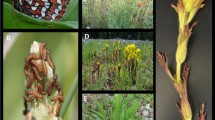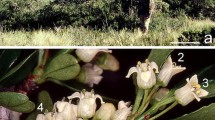Summary
The suitability of several Cruciferae species for the survival and development of the larvae of Anthocharis cardamines, which are seed and flower predators, was investigated. Large differences, consistent in time and space, were observed between the survival of sub-populations on different hostplants. Foodplants influenced A. cardamines survival and development by allelochemical and mechanical defences, which may also weaken a larva against pathogen attack. Oviposition by females appeared surprisingly maladaptive however with proportionately most eggs being laid on the hostplants yielding poorest larval survival, in opposition to previous expectations of coevolutionary theory. The evolutionary consequences of butterfly predation for Cruciferae are discussed, and juxtaposed to the needs of pollination.
Similar content being viewed by others
References
Atsatt P, O'Dowd AJ (1976) Plant defense guilds. Science 193:24–29
Blau PA, Feeny P, Contardo L, Robson D (1978) Allyl glucosinolate and herbivorous caterpillars: a contrast in toxicity and tolerance. Science 200:1296–1298
Brues CJ (1924) The specificity of foodplants in the evolution of phytophagous insects. Am Nat 58:127–144
Chapman RF (1974) The chemical inhibition of feeding by insects: a review. Bull Ent Res 64:339–363
Chew FS (1975) Coevolution of Pierid butterflies and their cruciferous foodplants. I. The relative quality of available resources. Oecologia (Berl) 20:117–127
Chew FS (1977a) II. The distribution of eggs on potential foodplants. Evol 31:568–579
Chew FS (1977b) The effects of introduced mustards (Cruciferae) on some native North American cabbage butterflies (Lep. Pier.) Athala 5:13–19
Chew FS, Rodman JE (1979) Plant resources for chemical defense in: GA Rosenthal and DH Janzen (eds), Herbivores: Their interaction with secondary plant metabolites. Academic Press. NY 1979 pp 271–306
Courtney SP (1980) Studies on the biology of the butterflies Anthocharis cardamines (L.) and Pieris napi (L.), in relation to speciation in Pierinae. Ph D Thesis, University of Durham
Courtney SP (1981) The population biology of Anthocharis cardamines (L.) (Lep. Pier.) in northern England. Submitted to Ecol. Ent.
David WAL, Ellaby S, Taylor G (1972) The effect of reducing the content of certain ingredients in a semi-synthetic diet on the incidence of granulosis virus disease in Pieris brassicae. J Invert Pathol 20:332–340
Dixon JA (1976) Timing of egg hatch and viability of the sycamore aphid Drepanosiphum platanoidis (Schr.) at bud burst of sycamore Acer pseudopatanus L. J Anim Ecol 45:593–604
Ehrlich PR, Raven H (1965) Butterflies and plants: a study in coevolution. Evol 18:568–608
Erickson JM, Feeny P (1974) Sinigrin: a chemical barrier to the black swallowtail butterfly Papilio polyxenes. Ecology 55:103–111
Feeny P (1976) Plant apparency and chemical defense. Rec Adv Phytochem 10:1–40
Ford EB (1945) ‘Butterflies’. New Naturalist Series, Collins, Glasgow.
Fraenkel HG (1959) The raison d'etre of secondary plant substances. Science 129:1466–1470
Free JB, Williams IH (1978) The responses of the pollen beetle Meligethes aeneus, and the seed weevil Centhorhynchus assinilis, to oil seed rape Brassica napus and other plants. J Appl Ecol 15:761–774
Hicks KL (1974) Mustard Oil glucosides: feeding stimulants for adult Cabbage Flea beetles (Col. Chrys.). Ann Ent Soc Am 67:261–264
Hicks KL, Tahvanainen JO (1974) Niche differentiation by crucifer-feeding flea beetles (Col. Chrys.). Am Midl Nat 91:406–423
Hovanitz W (1963) The relation of Pieris virginiensis Edw. to P napi L. J Res Lep 1:124–134
Krieger RI, Feeny P, Wilkinson CF (1971) Detoxification enzymes in the guts of caterpillars: an evolutionary answer to plant defences. Science 172:579–581
Lundgren L (1975) Natural plant chemicals acting as oviposition deterrents on Cabbage butterflies (P. brassicae, P. rapae and P. napi). Zoologica Scripta 4:253–258
Mitchell R (1977) Differential host selection by Pieris brassicae on Brassica oleracea. Ent expl et appl 22:208–211
Moon MS (1967) Phagostimulation of a monophagous aphid. Oikos 18:96–101
Mukherji MK, Harcourt DG (1970) Spatial pattern of the immature stages of Hylemya brassicae on Cabbage. Can Entomol 102:1216–1222
Nair KSS, McEwen FL, Alex JF (1973) Oviposition and development of Hylemya brassicae Bouche on cruciferous weeds. Proc Ent Soc Ont 104:11–15
Nielsen JK (1977) Hosplant relationships of Phyllotreta nemorum L. (Col. Chrys.) I. Field studies. Z Ang Ent 84:396–407
Pimentel D (1961) An evaluation of Insect Resistance in Broccoli, Brussels Sprouts, Cabbage, Collards and Kale. J Econ Ent 54:156–158
Rodman JE, Chew FS (1980) Phytochemical correlates of Herbivory in a community of Native and Naturalized Cruciferae. Biochem Syst Ecol 8:43–50
Schoonhoven LM (1972) Secondary plant substances and insects. Rec Adv Phytochem 5:197–224
Sehgal UK, Vjagir R (1977) Plant natural defences in Cruciferae and Tropaeolaceae against mustard sawfly Athalia proxima Klg. Indian J Ecol 4:199–205
Singer MC (1971) Evolution of foodplant preference in the butterfly Euphydryas editha. Evol 25:383–389
Verschaffelt E (1911) The cause determining the selection of food in some herbivorous insects. Proc Sci K Acad Wet Amsterdam 13:536–542
Whittaker RH, Feeny P (1971) Allelochemics: chemical interactions between species. Science 171:757–770
Wiklund C (1974) The concept of oligophagy and the natural habitats and hostplants of Papilio machaeon L. in Fennoscandia. Ent Scand 5:151–160
Wiklund C (1975) The evolutionary relationship between adult oviposition preferences and larval host plant range in Papilio machaon L. Oecologia (Berl) 18:185–197
Wiklund C, Ahrberg C (1978) Host plants, nectar source plants and habitat selection of males and females of Anthocharis cardamines. Oikos 31:169–183
Williams IH, Free JB (1979) Compensation of oil seed rape (Brassica napus) plants after damage to their buds and pods. J Agric Sci 92:53–59
Author information
Authors and Affiliations
Rights and permissions
About this article
Cite this article
Courtney, S.P. Coevolution of pierid butterflies and their cruciferous foodplants. Oecologia 51, 91–96 (1981). https://doi.org/10.1007/BF00344658
Received:
Issue Date:
DOI: https://doi.org/10.1007/BF00344658




